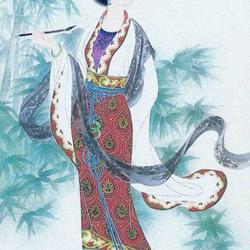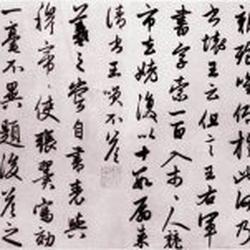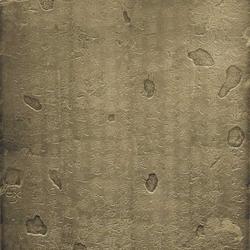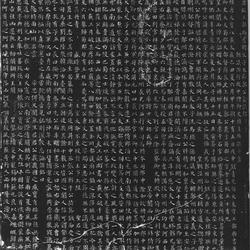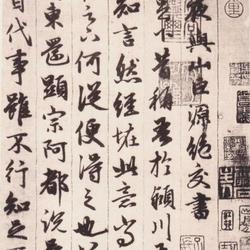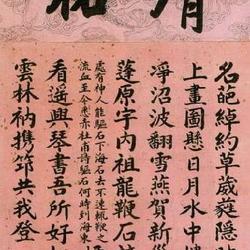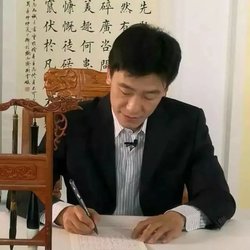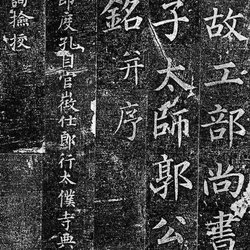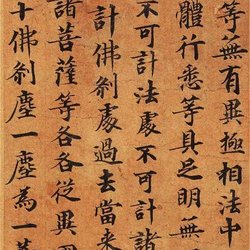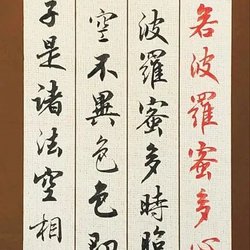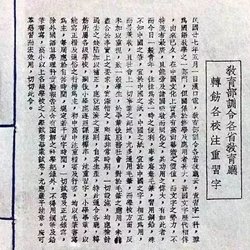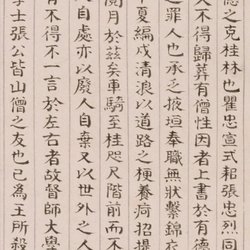Appreciation of the calligraphy of female calligraphers in the Qing Dynasty
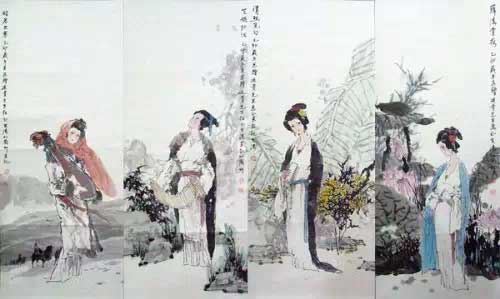
Most of the female literati and calligraphers in the past dynasties came from the two families of Lehu and ladies, and the Qing Dynasty was no exception. Lehu is just another name for geisha. Because of the need to make a living, they have to receive specialized talent training from an early age. Being good at music, chess, calligraphy, painting, wine, sex, and talent are the basic skills for making a living; Go to a higher level and become famous throughout the ages. This class is distributed in all major cities, but Kyoto and Wuyue, Jianghuai and others are particularly outstanding. Female historians Liu Rushi, Dong Xiaowan and others are even more prominent in Qinhuai and have famous works for thousands of years. Ladies rely on the influence of official families and scholarly family backgrounds. Due to the needs of their own interests, they can often enjoy good training, so their talents can be developed and improved. Ladies may be invisible among the people, or travel among scholars, or join the palace, or dominate the world. Most of them can enjoy an artistic life, such as Jiang Shuzhai, Wang Duanshu, Sun Yunfeng, Zhang Lunying, Wu Zao, Qiu Jin and others. In the early Qing Dynasty, Jiang Shuzhai (year of birth and death unknown), whose name was Zhang, also known as Guangping Neishi, was born in Jiaozhou in the early Qing Dynasty. She was active in the 17th century AD. She was a famous female calligrapher and poet during the Kangxi period of the Qing Dynasty. The calligraphy of female history should be recommended as the first one.
Liu Rushi(1618~1664), whose name was hidden, was later changed to Miwu, also known as Hedongjun. During the Ming and Qing dynasties, she was sold into a prostitute when she was 10 years old due to family difficulties. Because of her talent, beauty, and outstanding poetry and painting, she was ranked among the "Eight Beauties of Qinhuai". His Fengshen talent has been passed down for more than 300 years and has not faded to this day.
Liu Rushi is an outstanding player in all aspects of piano, chess, calligraphy, painting, and poetry. Modern Chinese masters Wang Guowei and Chen Yinke and the famous writer Yu Dafu all praised it. Liu Rushi's calm and vigorous calligraphy is the externalization and manifestation of his temperament, vision and mind. Weng Tonghe praised her calligraphy: "Improve the silver hook with an iron hand, and fill the paper with strange energy." However, her calligraphy art has never received the attention it deserves. Mr. Chen Yinke, Liu Rushi's calligraphy master, said in "Liu Rushi's Farewell Biography": "Among the celebrities that Hedong Jun has interacted with, Li Cunwo is especially famous for his Gongshu. The calligraphy of Hedong Jun (Liu Rushi's nickname) should be preserved by me. Its influence is undoubtedly." The calligraphy handed down by Liu Rushi mainly includes "Cao on the Lake" and Wanghailou couplet ink, as well as a small amount of couplet calligraphy.
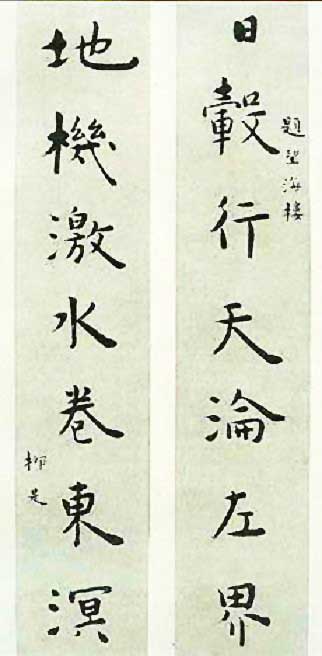
Regular script couplets from Liu Rushi's "Inscribed on Wanghai Tower" in the Qing Dynasty
"Inscribed on Wanghai Tower" is a couplet in Liu Rushi's regular script. The couplet is "the sun travels to the sky and falls to the left, and the earth stirs up the water to roll into the east." It is deeply influenced by the laws of Yu Shinan and Chu Suiliang among the "Four Schools of the Early Tang Dynasty" and has been incorporated into it. I am ancient and have my own style. Wang Duanshu is versatile, good at poetry, calligraphy and painting. Painting masters Ni and Mi also worked on flowers. Besides painting, calligraphy and poetry, he is especially good at history. According to Wang Shilu of the Qing Dynasty's "A Textual Research on Gong Wei's Ji Zhiwen", Wang Duanshu loved reading. She read all the classics, history, Yinfu, Laozhuang, Neidian, and Barnyard Official Unofficial History. She could be said to be well-read and knowledgeable. He is conceited in his talent, knowledge and knowledge, and wants to have many advantages, so all styles of poetry and prose are not involved in writing." Regarding Wang Duanshu's many talents, Lin Wenzhen, a female painter and poet in Putian, Fujian Province in the Qing Dynasty, wrote a poem "Self-titled Autumn Orchid and Painting to Reflect Ranzi" 》Exclusive praise. Yun Zhu of the Qing Dynasty said in his "Biography of the Lady Zhengshi" that she was highly talented, especially good at small regular script, and was the second king of regular script. Zhu Jia's "History of Calligraphy" lists her as a female calligrapher of the Qing Dynasty and introduces her.
Wang Duanshu (about 1620-1700), also known as Yuying, nicknamed Yingranzi, Yinhongzhu, and Qingwuzi, was the daughter of Wang Siren, a famous civil servant in the late Ming Dynasty, and a talented woman from Shanyin (now Shaoxing, Zhejiang Province) in the late Ming Dynasty and early Qing Dynasty. Wang Duanshu was immersed in family studies since she was a child, and she also worked in calligraphy and painting. Zhang Geng's "Painting Zhenglu" in the Qing Dynasty said that she was good at poetry and painting.
Wang Duanshu is versatile, good at poetry, calligraphy and painting. Painting masters Ni and Mi also worked on flowers. Besides painting, calligraphy and poetry, he is especially good at history. According to Wang Shilu of the Qing Dynasty's "A Textual Research on Gong Wei's Ji Zhiwen", Wang Duanshu loved reading. She read all the classics, history, Yinfu, Laozhuang, Neidian, and Barnyard Official Unofficial History. She could be said to be well-read and knowledgeable. He is conceited in his talent, knowledge and knowledge, and wants to have many advantages, so all styles of poetry and prose are not involved in writing." Regarding Wang Duanshu's many talents, Lin Wenzhen, a female painter and poet in Putian, Fujian Province in the Qing Dynasty, wrote a poem "Self-titled Autumn Orchid and Painting to Reflect Ranzi" 》Exclusive praise. Yun Zhu of the Qing Dynasty said in his "Biography of the Lady Zhengshi" that she was highly talented, especially good at small regular script, and was the second king of regular script. Zhu Jia's "History of Calligraphy" lists her as a female calligrapher of the Qing Dynasty and introduces her.
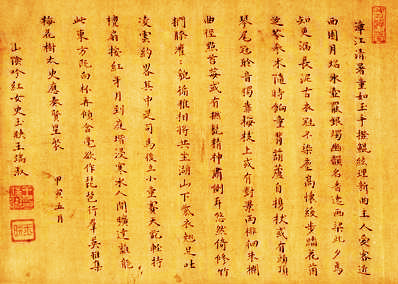
Qing Dynasty Wang Duanshu's "Postscript to Zhang Chong's Style in the West Garden" Handscroll Poems
Wang Duanshu's postscript "Zhang Chong's West Garden Style Hand Scroll" inscribed a poem with the inscription: "In the fifth month of Jiayin (1674), Shanyin Yin Red Girl Shi Yuying Wang Duanshu." The seal: "Shihaotang, Wang Duanshu's seal, Yuying." Commented by Weng Fanggang The title says, "The person who wrote the title at the end of the volume is all a well-known person of the generation, but the female historian Wang Yuyingyi has three unique abilities and is highly regarded in the art world. She is not the best." This shows how good it is.
Dong Xiaowan (1624-1651), whose given name was Bai, also known as Wanjun, whose first name was Qinglian, also known as Qinglian Nvshi. She was named after her admiration for Li Bai, a poet from the Tang Dynasty. A native of Nanjing, she ended up in a brothel because her parents were divorced and she lived in poverty. She was smart, graceful and beautiful. Together with eight famous prostitutes in Qinhuai Nanqu - Liu Rushi, Gu Hengbo, Ma Xianglan, Chen Yuanyuan, Kou Baimen, Bian Yujing and Li Xiangjun, she was called the "Eight Beauties of Jinling" by people at the time. Dong Xiaowan has been smart since he was a child. When he was eight years old, he studied poetry, calligraphy, painting, drama, and piano with a group of Qingke literati.
What Dong Xiaowan left to future generations was not only a sense of wonder, but also elegance. She is keen on recipe research, is proficient in poetry, is good at calligraphy and painting, and is especially good at painting peach blossoms. The small clump of cold trees painted by Xiaowan is charming and moving. The painting "Colorful Butterfly" created when he was 15 years old is now collected in Wuxi Museum. He is good at calligraphy in small regular script. He studied Zhong Yao for the first time and then switched to "Cao'e Stele". The ink marks are quite rare today, except for "Eleven self-composed seven-character poems for Qiu Gui" in small regular script on a gold paper fan.
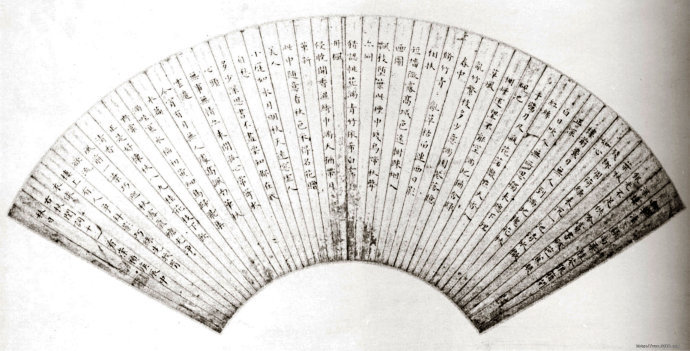
Qing Dynasty Dong Xiaowan's "Eleven self-composed seven-character poems for Qiu Gui"
"Eleven seven-character poems written by Qiu Gui Ci", small regular script on gold paper fan, 18.5 cm in length and 51.4 cm in width. Collection of Jilin Provincial Museum. This frame of Dong Xiaowan's regular script Qiu Gui poem is a rare work of calligraphy art, and it also has important reference value for researching the emotional experience of Dong and Maoxiang. Reading the poem carefully, feeling the sadness of autumn, one can feel the voice of a weak-headed woman pursuing freedom under the heavy constraints of feudal ethics. His regular script is neat and elegant, and his every detail captures the essence of ancient calligraphers.
Sun Yunfeng (1764~1814), courtesy name Biwu, was the eldest daughter of Lingyi (Chunyan) and a disciple of Yuan Mei. Able to write poems and flowers. His younger sisters, Yunhe, Yunluan, Yunhong, Yunque, and Yunjuan, were also good at poetry and painting. They were all smart and well-behaved since childhood. They studied poetry and lyrics with Yuan Mei, and they all became outstanding characters. Lei Jin's "Poetic Talk of a Lady" records that Sun Yunfeng was very smart when she was young. When she was eight years old, her father responded with a sentence from "The Book of Songs": "Guan Guan Ju Jiu", and she immediately responded: "刈刈刷雁雸".
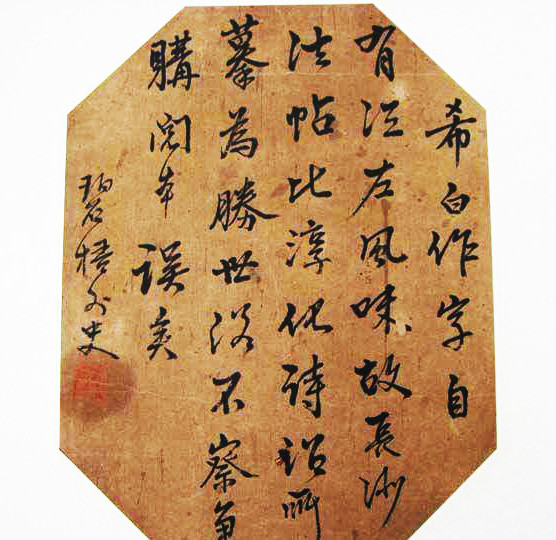
"On Xibai's Calligraphy" by Sun Yunfeng of the Qing Dynasty
"On Xibai's Calligraphy", written in fan-cursive script by Sun Yunfeng. Yuan Mei's "Suiyuan Poetry Talk" says: "Sun Yunfeng's poetry is both good and his calligraphy is also beautiful." His calligraphy is smart and elegant, without any need for carving, and is natural and leisurely, which is in line with his teacher Yuan Mei's idea of "spiritual nature". The laws are appropriate and the talents are abundant, so it is regarded as a masterpiece.
Zhang Lunying (1798~?), whose courtesy name was Wanfen, and whose family name was Luhuaiyin Hall. Zhang Qi's third daughter is Sun Jie. A native of Wujin, Jiangsu Province. Gongshu was praised by Bao Shichen. Her nature is gentle and gentle, her body is as weak as wearing clothes, but her writing is strong and resolute. The tribute envoys from Japan and Korea often bought his books and brought them back. Zhang Lunying is good at the Northern Stele, using Zheng Daozhao as his method , and his calligraphy is similar to that of Li Yong, a calligrapher of the Tang Dynasty. His official script is calm and plump, simple and rich. The writing techniques of seal, zhen and li are interchangeable. Her Wei stele is majestic and majestic , and she does not care about the gains and losses of every painting. But it is not just domineering, but strong yet soft, reflecting the feminine beauty of female calligraphy. Zhao Zhiqian especially praised Zhang Lunying, thinking that "there is no other calligrapher in the dynasty than Ms. Zhang Wanchuan of Yanghu named Lunying, and there is only one after Zheng Xibo". Zhang Lunying's calligraphy had a great influence on Zhao Zhiqian. His ink writings handed down from generation to generation include the vertical scroll of "Song Tingyu's Wife in Regular Script" and the four-striped screen in official script.
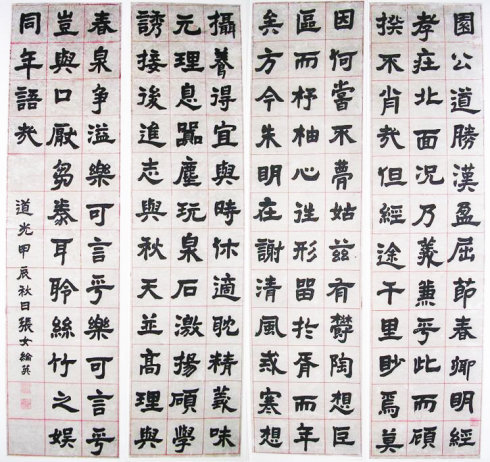
"Four Screens of Official Script" by Zhang Lunying of the Qing Dynasty
"Four Screens of Official Script" is a paper version of official script, with a length of 116 cm and a width of 30 cm. This book mainly uses the center of the pen, and also uses the side. The line of writing combines the circle with the square, combining the square and the circle. The structure is square, tight on the outside and loose on the inside, wide and natural. There is a slight tendency to lean to the right in the flatness, and the strangeness and rightness are intertwined. "Yuemantang Diary" praised him as "good at studying Beibei, with superb writing power, and prepared the method of seal script and official script".

"The Wife of Song Tingyu in Regular Script" by Zhang Lunying of the Qing Dynasty
"Song Tingyu's Wife in Regular Script" is a vertical scroll, in regular script on gold paper, with a length of 122.1 cm and a width of 29. centimeter. This is written on checked gold paper, and the writing is graceful and smooth. This regular script work may be a line in the Tongping screen, so it only has chapters but no inscriptions. The content written is also a kind of praise in the articles written by women of the previous generation. The author has a clear mind and an extraordinary momentum. Because few of her works have been handed down, the calligraphy and history circles often ignore her when discussing Qing dynasty epileologists. This is worth reflecting on.
Wu Zao (1799-1862), also known as Pingxiang and Yucenzi, was born in Yixian County, Anhui Province. His father was Baozhen, and his courtesy name was Fuwu. He was a physicist in Hangzhou, Zhejiang Province, and then immigrated to Renhe, Zhejiang Province (now Hangzhou). She hated the constraints of feudal ethics and created the drama "Drinking and Reading Shows". The protagonist in the play is Xie Xucai, who "grew up in a famous family, had a long history of sex, despised women, and did not love beauty." She painted herself as a man and cried bitterly while reading "Li Sao" on film. Naturally, Xie Xucai is Wu Zao's self-portrait.
He died at the age of sixty-four. He is the author of "Collection of Xiangnan Snow Beilu", "Poems of Hualian Bookstore", "Hualian Ci", and "Du Sao Tuqu". There are records in "Yi Lin" , "Hangzhou Prefecture Chronicles", "Xiling Boudoir Ode", "Essays of Liangbian Qiuyu'an", "A Survey of Boudoir Poets in the Qing Dynasty", "Records of Paintings", etc.
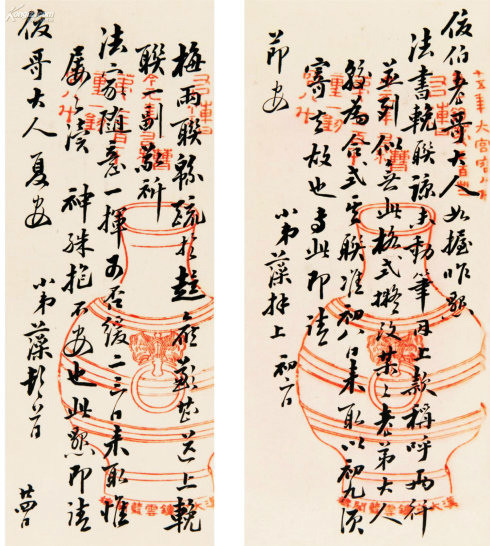
Letters to Sha Fu from Wu Zao, Qing Dynasty
Wu Zao was not only good at poetry, but also calligraphy and good at painting orchids. During the Jiaqing period from 1796 to 1820, he and Zhu Lunan (Yi) and more than 90 people formed a friendship with the Jinling Painting Society. There was a painting club in Maju Village (Shitu) that praised the painting. His books have not yet entered the mainstream of stele studies, but are unique among the two kings' calligraphy studies. His "Letter to Sha Fu" is as strong and free- spirited as a man's, without the delicate and weak qualities of a woman. It is a rare and excellent book.
Qiu Jin (1875-1907), formerly known as Qiu Guijin, also known as Ruiqing, also known as Xuanqing, nicknamed Danwu, and her nickname was Yugu. After traveling eastward, she changed her name to Jin and her nickname was Jingxiong. She called herself "Jianhu Heroine" and her pen name was Shuqian. He once used the pen name Bai Ping, and his ancestral home was Shanyin, Zhejiang (now Shaoxing). He was born in Xiamen, Fujian Province in 1877, the third year of Emperor Guangxu's reign in the Qing Dynasty. Patriot of modern democratic revolution.
Qiu Jingong's poetry and lyrics promote the democratic revolution and women's liberation. His writing style is vigorous, bold and tragic, and his emotions are deep. There is "Qiu Jin Collection". Qiu Jin's calligraphy originated from Ouyang Xun. The characters are slightly flat , and the graceful beauty of Nv's calligraphy is combined with the inner fortitude. The calligraphy style is open but dignified.
"Book of Poems in Running Script" has clean and firm writing and elegant and straight characters. It seems to have the bones of European characters and the majesty of Beihai. It also has a bold and vigorous poetic style. Appreciating the characters is like seeing the person. The passionate and angry emotions overflow between the lines. I feel that there is something there. An upright and upright spirit spread across his eyes!
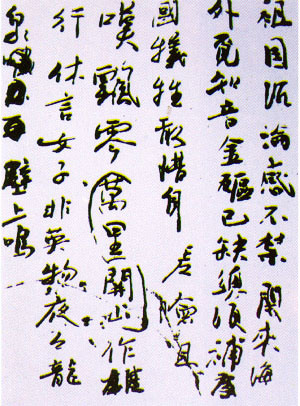
Qiu Jin of the Qing Dynasty "Partridge Sky: Can't help but feel the sinking of the motherland"
"Partridge Sky: I Can't Help Feeling the Motherland's Sinking" was written in 1904, not long after Qiu Jin arrived in Japan. Qiu Jin's determination to serve the country with her life and her courage to fly are vividly demonstrated. The heroic words of the whole poem are full of majestic character, which is supported by the poet's heroic appearance. The Shaoxing Prefecture of the Qing Dynasty published this poem as a "crime", which shows how revolutionary this poem is. The heroic spirit shines in the pen and ink, and the atmosphere is similar to the manuscript of Lu Gong's memorial to his nephew, which is praised as a masterpiece.

